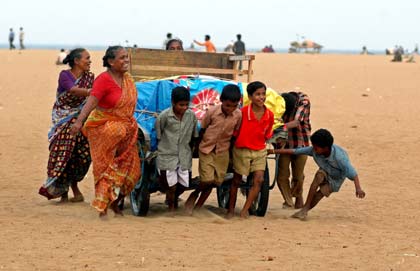Asia-Pacific
Tsunami kills over 300 in Indonesia
(AP)
Updated: 2006-07-18 11:21
 |
Large Medium Small |
 Local vendors evacuate Marina beach after a tsunami warning in the southern Indian city of Chennai July 17, 2006. India issued a tsunami warning for the Andaman and Nicobar islands, badly hit by the 2004 tsunami, but officials said there was no real threat. [Reuters] |
Regional agencies had warned that a 7.7-magnitude earthquake that struck 150 miles off Indonesia's southern coast was strong enough to create a tsunami on Java. But there was no warning system for those on the southern coast.
Meanwhile, thousands of terrified residents set up camp in the hills overlooking the sea.
The waves sent boats, cars and motorbikes crashing into resorts and fishing villages. Houses and restaurants were flattened along a 110-mile stretch of the densely populated island's southern coast.
Jan Boeken, from Antwerp, Belgium, said he was sitting at a bar when his waiter started screaming.
"I looked back at the beach and saw a big wall of thundering black water coming toward us," said the 53-year-old, who escaped with minor cuts to the head and knees. "I ran, but I got trapped in the kitchen, I couldn't get out. I got hit in the body by debris and my lungs filled with water."
Most of the victims were believed to be Indonesians, but at least one Swedish tourist was being treated for injuries at a hospital near Pangandaran and his two sons, 5 and 10, were missing, said Jan Janonius, a Swedish Foreign Ministry spokesman.
A witness told el-Shinta he saw the ocean withdraw 1,500 feet from the beach a half-hour before the powerful wave smashed ashore, a typical phenomenon before a tsunami.
"I could see fish jumping around on the ocean floor," Miswan said.
Witnesses said the wave came several hundred yards inland in some places. Buildings sit close to the beach in Pangandaran.
Pedi Mulyadi, a 43-year-old food vendor, said he was waiting on the beach for customers when the wave struck, killing his wife, Ratini, 33. The pair were clinging to one another when they were swallowed by the torrent of water and pulled 300 feet inland, he said.
"Then we were hit, I think by a piece of wood," Mulyadi said. "When the water finally pulled away, she was dead. Oh my God, my wife is gone, just like that."
Roads were blocked and power cut to much of the area. Damage and casualties were reported at several places along the 110 miles of beach affected, officials and media reports said.
"All the houses are destroyed along the beach," one woman, Teti, told el-Shinta radio. "Small hotels are destroyed and at least one restaurant was washed away."
Indonesia has installed a warning system across much of Sumatra island but not on Java. The government has been planning to extend the warning system there by 2007.
Java was hit seven weeks ago by a 6.3-magnitude earthquake that killed more than 5,800 people, but was spared by the 2004 tsunami that killed 216,000 people, nearly half of them in Indonesia's Aceh province.
Chris Goldfinger, an earthquake expert at the College of Oceanic and Atmospheric Sciences at Oregon State University, said Monday's quake was probably not related to the 2004 tsunami though some of the tremors in the region since then were related.
The May earthquake did not affect the part of the island hit by Monday's tsunami, which was spawned by a quake that struck deep beneath the Indian Ocean 150 miles southwest of Java's coast.
The quake struck at 3:24 p.m., causing tall buildings to sway hundreds of miles away in the capital, Jakarta. The strength of the temblor was revised upward from magnitude 7.1 after a review by a seismologist, the US Geological Survey said. The quake was followed by a series of powerful aftershocks.
After the quake, the Pacific Tsunami Warning Center and Japan's Meteorological Agency issued warnings saying there could be a tsunami in the Indian Ocean. The tsunami struck Java about an hour after the quake and its effects could be felt as far as Bali island and near Australia's Coco Islands.
Indonesia is on the so-called Pacific "Ring of Fire," an arc of volcanoes and fault lines encircling the Pacific Basin.